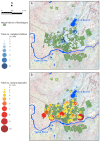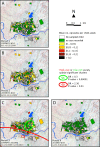Spatio-temporal analysis of malaria within a transmission season in Bandiagara, Mali
- PMID: 23452561
- PMCID: PMC3618208
- DOI: 10.1186/1475-2875-12-82
Spatio-temporal analysis of malaria within a transmission season in Bandiagara, Mali
Abstract
Background: Heterogeneous patterns of malaria transmission are thought to be driven by factors including host genetics, distance to mosquito breeding sites, housing construction, and socio-behavioural characteristics. Evaluation of local transmission epidemiology to characterize malaria risk is essential for planning malaria control and elimination programmes. The use of geographical information systems (GIS) techniques has been a major asset to this approach. To assess time and space distribution of malaria disease in Bandiagara, Mali, within a transmission season, data were used from an ongoing malaria incidence study that enrolled 300 participants aged under six years old".
Methods: Children's households were georeferenced using a handheld global position system. Clinical malaria was defined as a positive blood slide for Plasmodium falciparum asexual stages associated with at least one of the following signs: headache, body aches, fever, chills and weakness. Daily rainfall was measured at the local weather station.Landscape features of Bandiagara were obtained from satellite images and field survey. QGIS™ software was used to map malaria cases, affected and non-affected children, and the number of malaria episodes per child in each block of Bandiagara. Clusters of high or low risk were identified under SaTScan(®) software according to a Bernoulli model.
Results: From June 2009 to May 2010, 296 clinical malaria cases were recorded. Though clearly temporally related to the rains, Plasmodium falciparum occurrence persisted late in the dry season. Two "hot spots" of malaria transmission also found, notably along the Yamé River, characterized by higher than expected numbers of malaria cases, and high numbers of clinical episodes per child. Conversely, the north-eastern sector of the town had fewer cases despite its proximity to a large body of standing water which was mosquito habitat.
Conclusion: These results confirm the existence of a marked spatial heterogeneity of malaria transmission in Bandiagara, providing support for implementation of targeted interventions.
Figures





References
-
- World Health Organization Expert Committee on Malaria. World malaria report. Geneva: WHO; 2011.
-
- Ministère de la Santé, Secrétariat général. Direction nationale de la Santé. Mali: Annuaire Système Local d’Information Sanitaire (SLIS); 2009.
-
- Cattani JA, Tulloch JL, Vrbova H, Jolley D, Gibson FD, Moir JS, Heywood PF, Alpers MP, Stevenson A, Clancy R. The epidemiology of malaria in a population surrounding Madang, Papua New Guinea. AmJTrop Med Hyg. 1986;35:3–15. - PubMed
Publication types
MeSH terms
Grants and funding
LinkOut - more resources
Full Text Sources
Other Literature Sources

